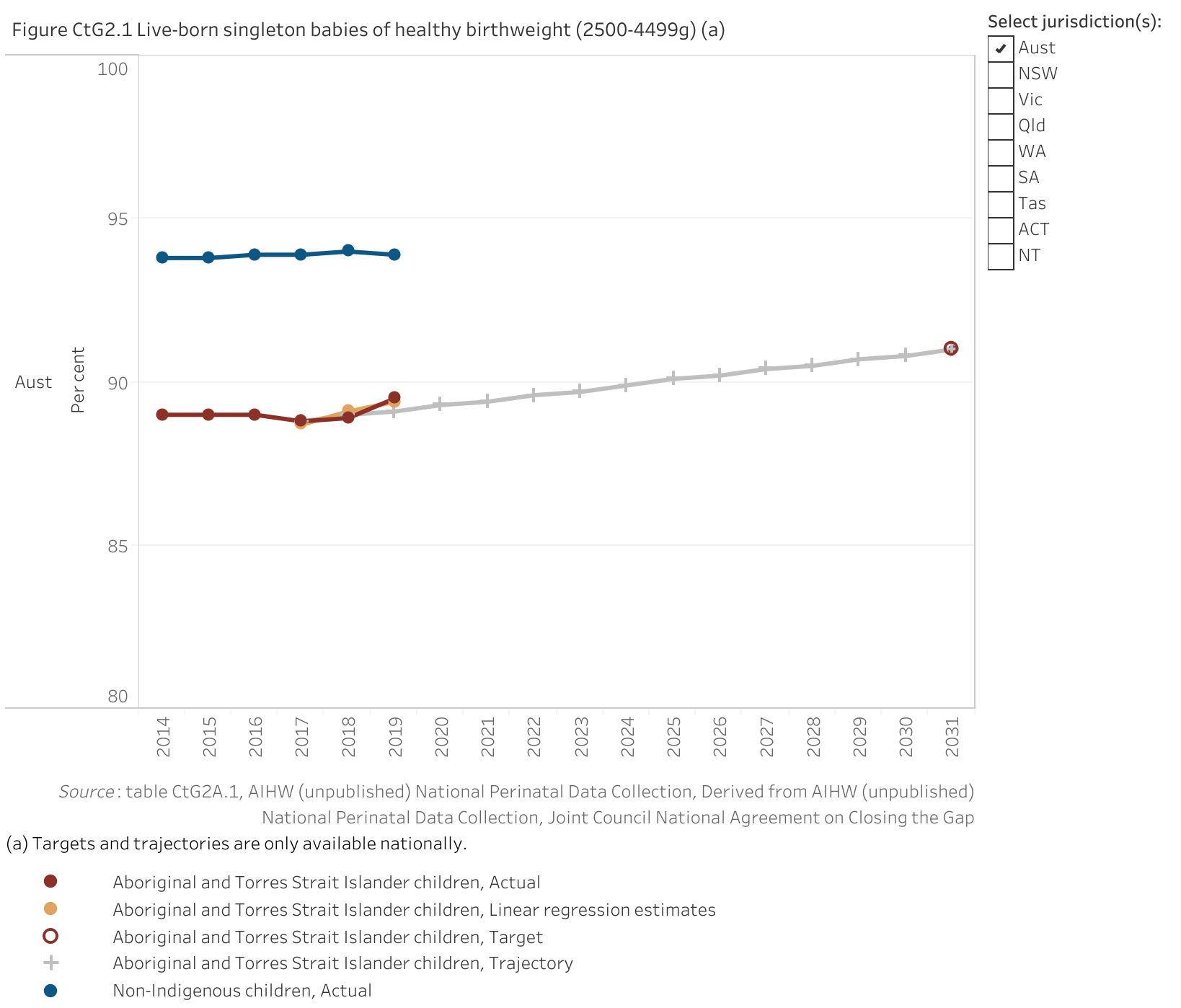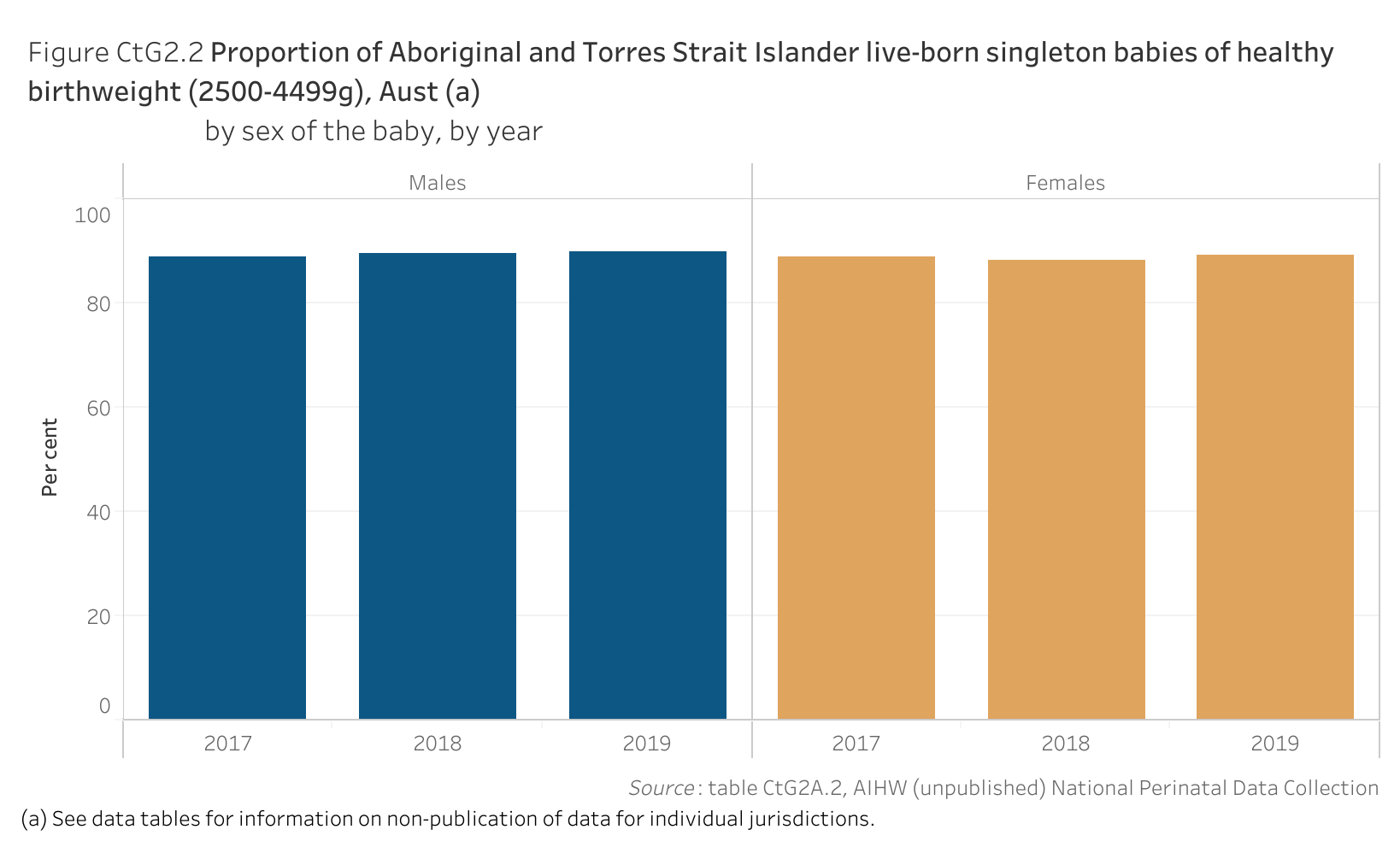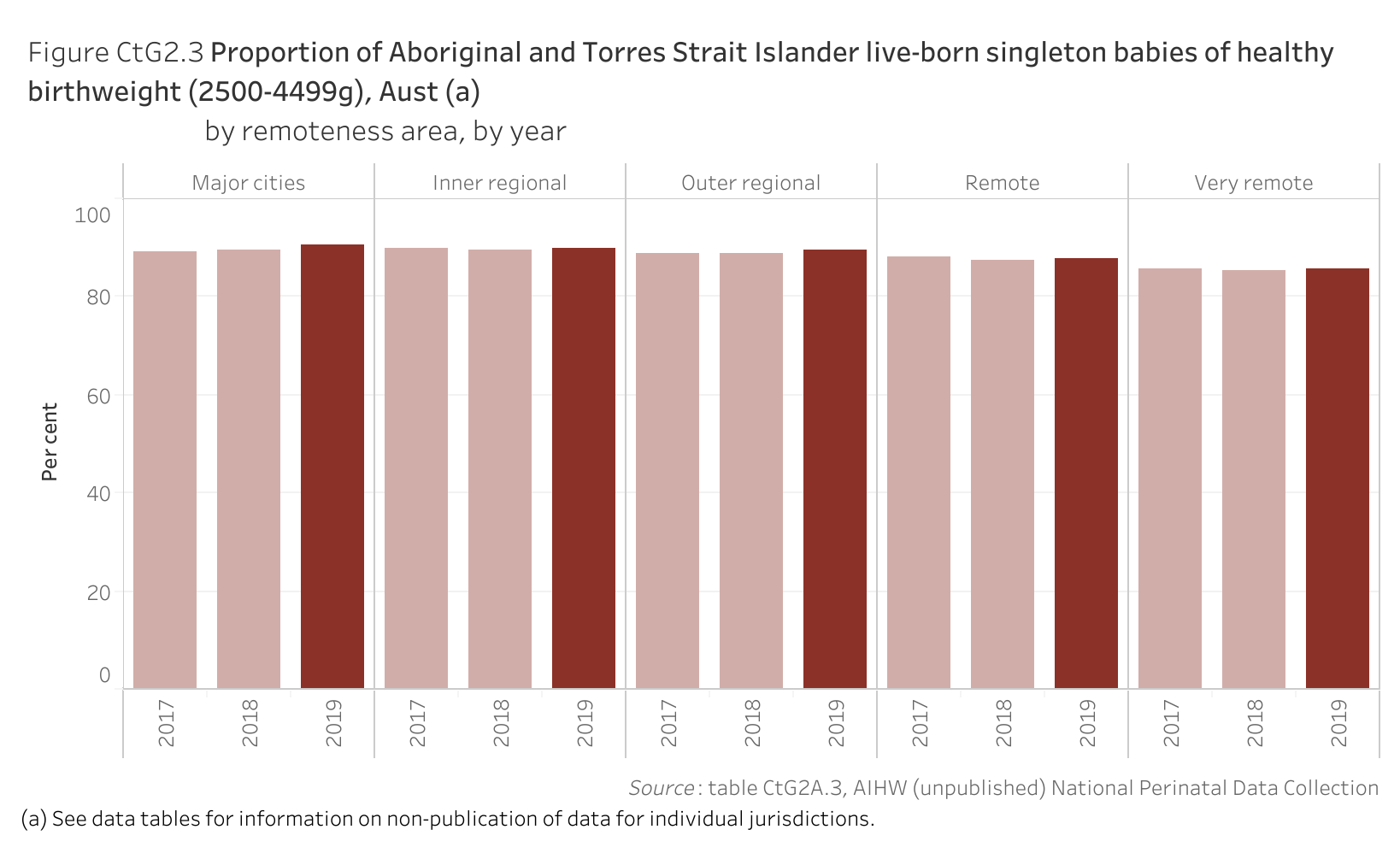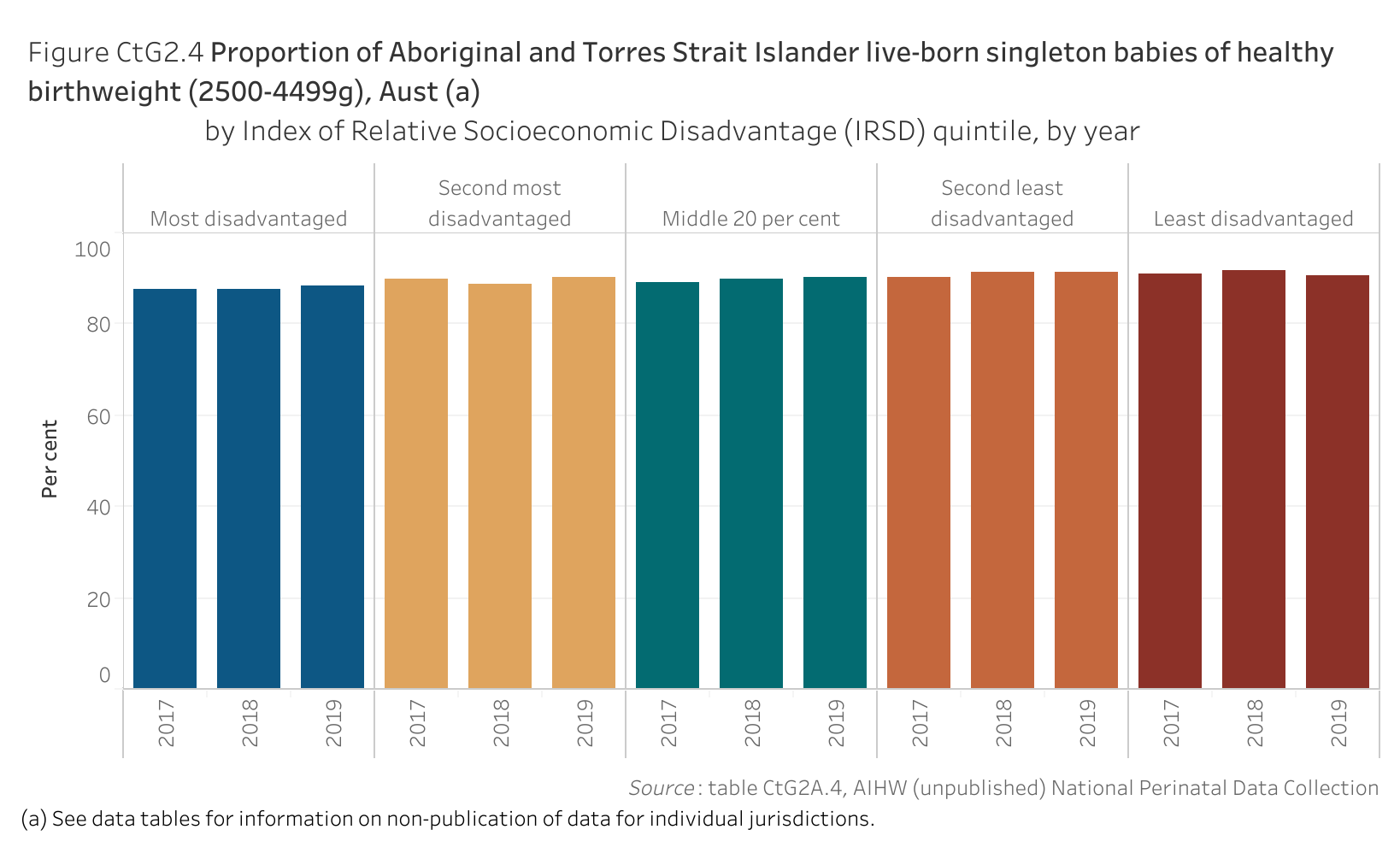Target 2
By 2031, increase the proportion of Aboriginal and Torres Strait Islander babies with a healthy birthweight to 91 per cent.
Dashboard snapshot: The data below are the most recent at the time of preparing the July 2022 report. Please go to the dashboard to access the current data.
Nationally in 2019, 89.5 per cent of Aboriginal and Torres Strait Islander babies born were of a healthy birthweight (figure CtG2.1).
This is an increase from 88.8 per cent in 2017 (the baseline year).
Nationally, based on progress from the baseline, the target shows good improvement and is on track to be met. However, this assessment should be used with caution as it is based on a limited number of data points. Please see the How to interpret the data page for more information.

| NSW | Vic | Qld | WA | SA | Tas | ACT | NT | Aust | |
|---|---|---|---|---|---|---|---|---|---|
| Assessment |
improvement
no change
worsening not applicable as required data not available.
good improvement and target on track to be met.
improvement but target not on track to be met.
Note: These assessments of progress should be used with caution as they are based on a limited number of data points.
Disaggregations
By sex of the baby
Nationally in 2019, 89.9 per cent of Aboriginal and Torres Strait Islander boys born and 89.2 per cent of girls born were of a healthy birthweight (figure CtG2.2).

| 2017 | 2018 | 2019 | |
|---|---|---|---|
| Males | 89.0 | 89.5 | 89.9 |
| Females | 88.7 | 88.3 | 89.2 |
By remoteness area
Nationally in 2019, the proportion of Aboriginal and Torres Strait Islander babies born of a healthy birthweight was highest in major cities and regional areas (ranging from 89.5 per cent in outer regional areas to 90.7 per cent in major cities), with the proportion lower in more remote areas (87.7 per cent in remote areas and 85.7 per cent in very remote areas) (figure CtG2.3).

| 2017 | 2018 | 2019 | |
|---|---|---|---|
| Major cities | 89.2 | 89.7 | 90.7 |
| Inner regional | 89.9 | 89.6 | 89.9 |
| Outer regional | 88.9 | 88.8 | 89.5 |
| Remote | 88.2 | 87.5 | 87.7 |
| Very remote | 85.7 | 85.2 | 85.7 |
By Index of Relative Socioeconomic Disadvantage (IRSD) quintile
Nationally in 2019, the proportion of Aboriginal and Torres Strait Islander babies born of a healthy birthweight was similar across all areas of relative socioeconomic disadvantage (between 90.1 and 91.5 per cent), except the most disadvantaged socioeconomic areas of Australia (88.4 per cent) (figure CtG2.4).

| 2017 | 2018 | 2019 | |
|---|---|---|---|
| Most disadvantaged | 87.7 | 87.7 | 88.4 |
| Second most disadvantaged | 89.8 | 88.8 | 90.1 |
| Middle 20 per cent | 89.3 | 90.0 | 90.4 |
| Second least disadvantaged | 90.3 | 91.5 | 91.5 |
| Least disadvantaged | 90.9 | 91.8 | 90.8 |
Target data specifications
Outcome: |
Aboriginal and Torres Strait Islander children are born healthy and strong. |
|---|---|
Target: |
By 2031, increase the proportion of Aboriginal and Torres Strait Islander babies with a healthy birthweight to 91 per cent. |
Indicator: |
The proportion of Aboriginal and Torres Strait Islander babies with a healthy birthweight. |
Measure: |
The measure is defined as: Numerator — number of live born singleton Aboriginal and Torres Strait Islander babies who weighed between 2500 and 4499 grams at birth Denominator — total number of live born singleton Aboriginal and Torres Strait Islander babies and is presented as a percentage. |
Target established: |
National Agreement on Closing the Gap July 2020 |
Latest dashboard update: |
30 June 2022 |
Indicator type: |
Target |
Interpretation of change: |
A high or increasing proportion is desirable. |
Data source(s): |
Name: AIHW National Perinatal Data Collection (NPDC) Frequency: Annual (2017 data for state and territory revised (previously np) and a small number of other cells revised throughout) Documentation (links): https://www.aihw.gov.au/about-our-data/our-data-collections/national-perinatal-data-collection |
Data provider: |
Provider name: Australian Institute of Health and Welfare Provider area: Perinatal |
Baseline year: |
2017 |
Latest reporting period |
2019 |
Target year: |
2031 |
Disaggregations: |
State and territory and Australia, by birthweight range, by Indigenous status of the baby. State and territory and Australia, by birthweight range, by Indigenous status of the baby, by sex of the baby. State and territory and Australia, by birthweight range, by Indigenous status of the baby, by remoteness area. State and territory and Australia, by birthweight range, by Indigenous status of the baby, by Index of Relative Socioeconomic Disadvantage (IRSD) quintile. |
Computation: |
Numerator divided by Denominator multiplied by 100 Counting rules Data relate to live births. Births both less than 20 weeks gestation and less than 400 grams birthweight are not included in the NPCD. Healthy birthweight is defined as babies who weighed between 2500 and 4499 grams at birth; low birthweight (400 grams to less than 2500 grams); high birthweight (4500 grams and over). Data are by geographic area of usual residence of the mother. Indigenous status is of the baby. Excludes (both numerator and denominator):
Disaggregations: Sex relates to biological primary sexual characteristics. Births classified as ‘indeterminate/not stated’ are excluded from the analysis by sex. Remoteness area is classified according to the ABS 2016 Australian Statistical Geography Standard (ASGS) using SA2 as the building block. Births to mothers whose usual residence is categorised as ‘migratory’ are excluded from the analysis by remoteness. Data exclude babies where the information on the usual residence of the mother was not sufficient to identify her geographic area and assign a remoteness area. Socioeconomic status of the locality is classified according to the Socioeconomic Indexes for Areas (SEIFA): Index of Relative Socioeconomic Disadvantage (IRSD), 2016 using SA2 as the building block. Data are reported by IRSD quintile that are determined at the Australian level. Data excludes babies where the information on the usual residence of the mother was not sufficient to identify her geographic area and assign a socioeconomic status of the locality. Supporting calculations Variability bands (provided for proportions). See the How to interpret data page for further information. |
Data quality considerations: |
In the NPDC, Indigenous status is a measure of whether a person identifies as being of Aboriginal and/or Torres Strait Islander origin. All jurisdictions have a data item to record Indigenous status of the mother and Indigenous status of the baby on their perinatal form, although there are some differences among the jurisdictions. Birthweight data on Aboriginal and Torres Strait Islander babies born to mothers residing in the ACT should be viewed with caution as they are based on small numbers of births. The AIHW does not provide data for proportions based on denominators of less than 100 for reliability reasons (mostly births with Indigenous status not stated). Proportions based on numerators of less than five are also not provided (np), with the exception of ‘not stated’ categories. Consequential suppression (np) has been applied to prevent back-calculation of small numbers. However, relevant data are included in the calculation for Australian totals. |
Future reporting: |
Additional disaggregations required for future reporting:
|
Supporting indicators
Driver
- Proportion of mothers who smoke during pregnancy by age groups
Any time, or after 20 weeks
- Proportion of mothers who consume alcohol during pregnancy by age groups
- Proportion of pregnant mothers with a pre-existing health condition
Gestational diabetes, obesity, hypertension, other
- Use of antenatal care by pregnant women
- proportion with five or more antenatal visits
- proportion with at least one antenatal care visit in the first trimester
- Proportion of pre-term births
Contextual information
- Progress towards parity
Material for download
- Children are born healthy and strong data tables (XLSX - 133 Kb)
- Children are born healthy and strong dataset (CSV - 347 Kb)
To assist with interpretation of the data provided (Excel data tables and CSV dataset) please refer to the target data specification (above) and the indicator data specifications (provided in each supporting indicator page – linked above).
